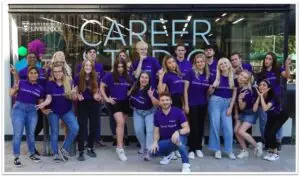‘Sometimes you want to go where everybody knows your name,
And they’re always glad you came.’
Cheers theme song
The TV sitcom Cheers was one of the world’s most successful comedies. Set in a Boston bar, the programme centred around the lives of a group of people who came together to drink and socialise. But as with all great comedies, what made the show funny was its ability to tackle serious issues, and none more so than the twin issues of belonging. For no matter how tough and disappointing their lives, each of the show’s characters had a place to go where, as the show’s theme tune put it, ‘everybody knows your name.’ That need for belonging is universal: for some of us, it means family, for others, a group of friends. And for millions of others, it means the workplace.
As businesses prepare to bring their teams back to the office, never has the issue of belonging – of being known, recognised, and appreciated – been more important. The past year has seen many organisations operate in survival mode. Workers have been furloughed or forced to work from home. As lockdown has dragged on, new habits have formed, new working arrangements taken hold. For many, working from home has become second nature; the thought of commuting and spending hours surrounded by colleagues and fellow workers seem like a distant memory.
Breaking habits
According to psychologists it can take anything from eighteen to 254 days to form a new habit, and an average of sixty-six days for a new behaviour to become automatic. Within the next few months, managers are going to discover just how embedded these habits have become throughout their workforce.
Perhaps haunted by memories of failed diets and abandoned fitness campaigns many bosses are seeking to swerve the challenge of trying to get everyone back to the office by pinning their hopes on ‘hybrid’ work patterns in which employees divide their time equitably between the office and home. In this, they are encouraged by surveys such as that by the McKinsey Global Institute which estimates that more than 20 percent of the global workforce could work the majority of its time away from the office—and be just as effective.
The appeal of hybrid working is easy to see. For Baby Boomers (those in their late fifties and over) and Generation X (late forties to mid-fifties) hybrid working reduces the stresses of balancing work and families while save time and money on commuting and other work-related expenses. With ample career capital under their belts, older workers have the networks and know-how to navigate the post-Covid work landscape – even if that means blurring the boundaries between work and home. As Cheers would have it, everybody (already) knows their name.
For younger workers, working from home is a career calamity.
Generation Covid
Starting work just before or during lockdown, ‘Generation Z’ (aged under 25) have had few opportunities to become established in the workplace. If they weren’t furloughed, theirs were the careers most likely to be put on hold. Not that they’ve complained. Never in peacetime have so many young people so willingly put their careers, education and lives on hold on behalf of others, and paid the price with disrupted plans and lost opportunities.
Think what they’ve missed: face to face meetings; live conferences; face-to-face training events; ‘watercooler’ chats with colleagues; opportunities to impress the boss; working lunches; post-work drinks … no wonder they’re the least likely of all the generations to want to continue working from home.
From my own research, I’ve discovered that what young workers have particularly missed during the past year are those culture-enhancing moments that bring people together and help create a sense of belonging. After a year spent online, it’s easy to underestimate how important these moments are and how dependent they are on proximity – being in the same place at the same time as others. Zoom calls are good for transactional work, but when it comes to trying to establish yourself in a new role, nothing can compare with being present in the same room with experienced colleagues.
As one employee told the Financial Times recently:
“I realised how much I rely on face-to-face meetings when establishing myself in a new job. Having to engage over video calls makes it doubly difficult: it’s hard to pick up on body language, so you have to ask for feedback directly, which is harder because it’s a very intense medium for sensitive conversations.”
If Generation Z is to avoid becoming Covid’s lost generation, it is essential that businesses put in place strategies for getting young employees back into the office and helping them acquire the sense of belonging and recognition that other generations have taken for granted. It won’t happen by itself; the time for action has arrived.
5 Ways to Fast-Track Generation Z
Now is the time for all of us to come together to kickstart the careers of Generation Z and to launch a concerted effort to help them make up lost ground. Below are five ways that managers can play a significant role in getting our youngest employees back on track.
1. Listening: the 40-Second Rule
Medical research has found that patients with doctors who spend just 40-seconds a day listening uninterruptedly to them, have much better levels of recovery than those whose doctors rarely ask them how they feel. The same applies in the workplace. Spending time asking your youngest employees how they feel, and what they think, will contribute considerably in helping them feel that they belong in the organisation. And all you have to do is listen. The results will amaze you.
2. Back-Onboarding
Returning to the office is an excellent opportunity to put all your youngest workers (I suggest Generation Z and Millennials) through a ‘back onboarding’ programme where you comprehensively re-induct them into your organisation. That means introducing them to the organisation’s strategy, goals and objectives. It also means taking time to reacquaint them with etiquette and expected standards of behaviour – take nothing for granted.
3. Peer learning
An effective, tried-and-tested way to help build a sense of belonging among Generation Z is to set up peer-assisted learning programmes where slightly more experienced recruits get to help newer recruits work through tricky problems or issues which previous recruits have found difficult. The benefits are twofold – both for the new hire and the slightly more experienced recruit. Peer assisted learning has been a huge success in universities and with the support of a senior leader there’s no reason why it can’t thrive in a business environment. Get one of your managers to lead on it.
4. Projects that matter
There’s nothing like early responsibility for fast-tracking new recruits into the workplace. PTM (Projects That Matter) are an ideal vehicle for giving young employees experience, insight, and exposure – put them in charge of an important project (a ‘back-onboarding programme, for example) and ask them to present their ideas to the Board.
5. Real-time Reviews
I’ve never met an organisation where the employees were impressed by the annual performance review. Even before Covid, Generation Z viewed annual reviews or appraisals as outdated. For them, annual feedback from a manager is an anachronism. What they want, indeed, what they expect, is ongoing, real-time feedback, with clear objectives and quantifiable actions.







